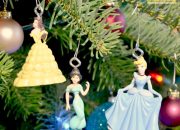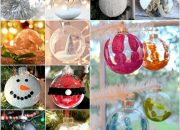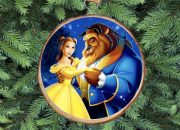Historical Context of 1992 Swarovski Christmas Ornaments

1992 swarovski christmas ornament – The year 1992 marked a significant period in both global design trends and Swarovski’s manufacturing processes. Christmas ornaments of the era reflected a broader movement towards nostalgia and traditional aesthetics, often featuring classic shapes, rich colors, and intricate detailing. Simultaneously, Swarovski, a company known for its precision-cut crystal, continued to refine its manufacturing techniques to produce increasingly complex and visually stunning pieces.
This confluence of factors shaped the character of Swarovski’s 1992 Christmas ornament collection.
Design Trends in 1992 Christmas Ornaments, 1992 swarovski christmas ornament
The overall aesthetic of Christmas ornaments in 1992 leaned towards a revival of traditional styles. While modern designs certainly existed, a significant portion of the market embraced classic shapes like stars, bells, and angels, often rendered in rich, jewel-toned colors or metallic finishes. Intricate hand-painting and detailed embellishments were also popular, reflecting a desire for handcrafted quality and personalized decoration.
This trend towards traditional aesthetics was a counterpoint to some of the more minimalist designs that had emerged in previous decades. The ornaments frequently incorporated elements of Victorian-era design or evoked a sense of old-world charm.
Swarovski’s Manufacturing Processes in 1992
Swarovski’s manufacturing processes in 1992 were characterized by a high degree of precision and automation, coupled with skilled craftsmanship. The company’s renowned expertise in crystal cutting remained central to its production. This involved meticulously cutting and polishing individual crystal pieces to achieve the desired facets and brilliance. Advanced machinery assisted in the mass production of these components, ensuring consistency and quality.
However, the assembly of the ornaments often involved hand-finishing and detailed work to create the final product. Quality control was rigorous, reflecting Swarovski’s commitment to producing high-quality, durable items.
Materials Used in 1992 Swarovski Ornaments
The primary material used in Swarovski’s 1992 Christmas ornaments was, of course, the company’s signature crystal. Various cuts and sizes of crystal were employed, depending on the specific design. These crystals were often combined with other materials to enhance the ornaments’ visual appeal and structural integrity. Examples of these materials include metal alloys (for frames or hanging mechanisms), paints (for detailed decoration), and possibly even some forms of high-quality plastics or resins for supporting structures.
The precise combination of materials varied across the ornament range.
Marketing and Distribution Strategies for 1992 Swarovski Ornaments
Marketing of the 1992 Swarovski Christmas ornaments likely relied heavily on the established brand reputation and the inherent appeal of high-quality crystal. Advertising campaigns probably focused on the elegance, sparkle, and collectability of the ornaments, targeting a discerning consumer base. Distribution channels likely included Swarovski’s own retail stores, select department stores specializing in luxury goods, and possibly mail-order catalogs, which were still a significant retail avenue in 1992.
The emphasis was on positioning the ornaments as premium, collectible items rather than mass-market decorations.
The 1992 Swarovski Christmas ornament, a collectible item for many, represents a specific point in time and design aesthetic. Its intricate craftsmanship is a testament to the artistry involved in creating such pieces. For those interested in exploring a wider range of Christmas ornament styles, you might also find interest in the diverse collection available at christmas ornament die hard , which offers a different perspective on holiday decoration.
Ultimately, appreciating the 1992 Swarovski ornament helps us understand the evolution of Christmas decorations throughout the years.
Cultural Significance and Nostalgia

Christmas ornaments in the 1990s held a significant cultural position, reflecting a blend of traditional values and emerging trends. The decade saw a rise in mass-produced, yet often highly decorative, ornaments, catering to a growing consumer market eager for festive embellishments. These ornaments served as tangible representations of family traditions and the spirit of the season, often passed down through generations or carefully curated to reflect personal tastes.
The emphasis was on creating a visually appealing and memorable Christmas experience, with ornaments playing a central role in this endeavor.The 1992 Swarovski ornaments epitomized this trend. Their exquisite craftsmanship, use of sparkling crystal, and often intricate designs aligned with the growing consumer desire for luxury and high-quality goods. The year 1992, while not marked by any single defining Christmas ornament trend, saw a continuation of the opulent styles prevalent throughout the late 1980s and early 1990s, reflecting a period of relative economic prosperity in many parts of the world.
The designs themselves, often featuring delicate animals, festive motifs, or elegant geometric patterns, reflected the prevailing aesthetic preferences of the time, which leaned towards both classic elegance and a touch of playful whimsy.
Nostalgia’s Role in the Enduring Appeal of Vintage Ornaments
The continued appeal of vintage Christmas ornaments, including those from 1992, is deeply rooted in nostalgia. These ornaments evoke powerful memories and emotional connections for many individuals, serving as tangible links to past Christmases and cherished family traditions. Their unique designs, often unavailable in modern collections, represent a bygone era and a simpler time, holding a sentimental value that transcends their purely decorative function.
The craftsmanship and materials used in vintage ornaments, particularly those like Swarovski, often surpass the quality of mass-produced items today, contributing to their enduring desirability among collectors and enthusiasts. The rarity of specific designs further enhances their appeal, transforming them into sought-after collectibles.
A Personal Remembrance of a 1992 Swarovski Ornament
My grandmother, a woman of impeccable taste, always adorned our family Christmas tree with a collection of exquisite ornaments. Among her favorites was a 1992 Swarovski angel, its wings delicately crafted from clear crystal, shimmering with an ethereal glow under the Christmas tree lights. I remember as a child, mesmerized by its intricate detail and the way the light refracted through the crystal, creating a magical, almost otherworldly effect.
Each year, as the tree was decorated, this angel held a special place, a silent witness to our family’s Christmas celebrations. Even now, many years later, seeing a similar ornament evokes that same sense of wonder and cherished memories of Christmases past. The delicate angel, a tiny piece of sparkling crystal, represents far more than just a decoration; it is a tangible link to a time of innocence, family, and the magic of Christmas.
FAQ Resource
How can I tell if my 1992 Swarovski ornament is authentic?
Look for the Swarovski signature and any accompanying markings indicating the year of manufacture. Authentic ornaments will generally exhibit superior craftsmanship and crystal clarity.
Where can I find information on specific 1992 Swarovski ornament designs?
Online auction sites, specialized collector forums, and antique shops are good places to start your search. Reference books on Swarovski collectibles can also provide valuable information.
What is the average lifespan of a well-maintained 1992 Swarovski ornament?
With proper care, a 1992 Swarovski ornament can last for decades, even generations. Avoid exposing it to extreme temperatures or humidity.








